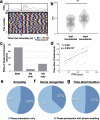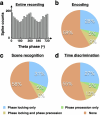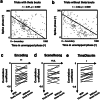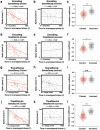Theta phase precession supports memory formation and retrieval of naturalistic experience in humans
- PMID: 39363119
- PMCID: PMC11659172
- DOI: 10.1038/s41562-024-01983-9
Theta phase precession supports memory formation and retrieval of naturalistic experience in humans
Abstract
Associating different aspects of experience with discrete events is critical for human memory. A potential mechanism for linking memory components is phase precession, during which neurons fire progressively earlier in time relative to theta oscillations. However, no direct link between phase precession and memory has been established. Here we recorded single-neuron activity and local field potentials in the human medial temporal lobe while participants (n = 22) encoded and retrieved memories of movie clips. Bouts of theta and phase precession occurred following cognitive boundaries during movie watching and following stimulus onsets during memory retrieval. Phase precession was dynamic, with different neurons exhibiting precession in different task periods. Phase precession strength provided information about memory encoding and retrieval success that was complementary with firing rates. These data provide direct neural evidence for a functional role of phase precession in human episodic memory.
© 2024. The Author(s).
Conflict of interest statement
Competing interests: The authors declare no competing interests.
Figures
















References
-
- Lisman, J. E. & Idiart, M. A. Storage of 7 ± 2 short-term memories in oscillatory subcycles. Science267, 1512–1515 (1995). - PubMed
-
- Hopfield, J. J. Pattern recognition computation using action potential timing for stimulus representation. Nature376, 33–36 (1995). - PubMed
-
- Bi, G. & Poo, M. Synaptic modification by correlated activity: Hebb’s postulate revisited. Annu. Rev. Neurosci.24, 139–166 (2001). - PubMed
-
- Jensen, O. & Lisman, J. E. Position reconstruction from an ensemble of hippocampal place cells: contribution of theta phase coding. J. Neurophysiol.83, 2602–2609 (2000). - PubMed
MeSH terms
Grants and funding
- K99 NS126233/NS/NINDS NIH HHS/United States
- R00 NS126233/NS/NINDS NIH HHS/United States
- U01NS117839/U.S. Department of Health & Human Services | NIH | National Institute of Neurological Disorders and Stroke (NINDS)
- K99NS126233/U.S. Department of Health & Human Services | NIH | National Institute of Neurological Disorders and Stroke (NINDS)

